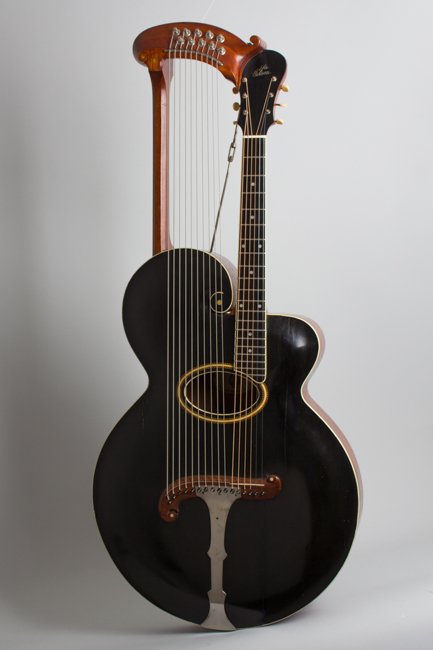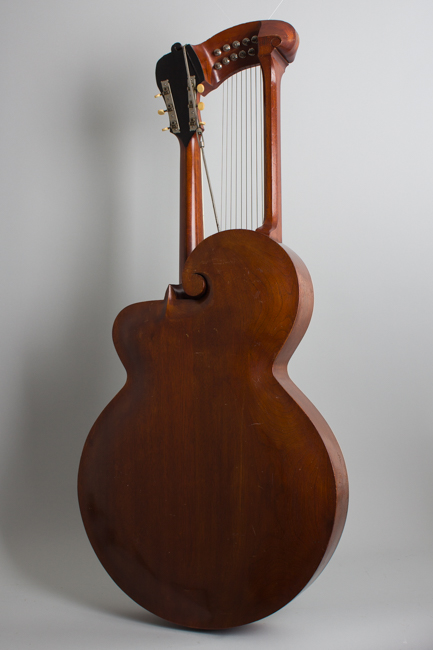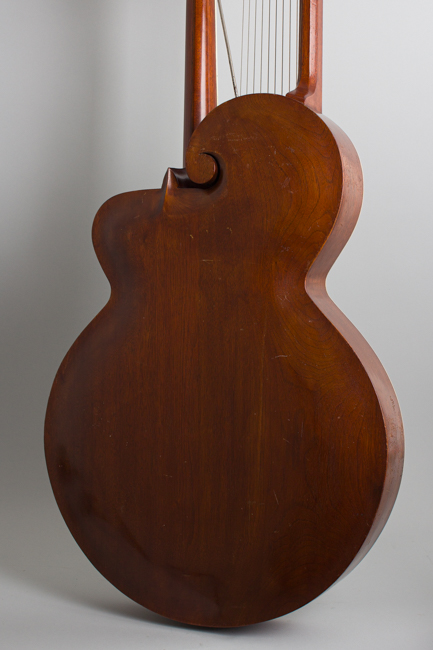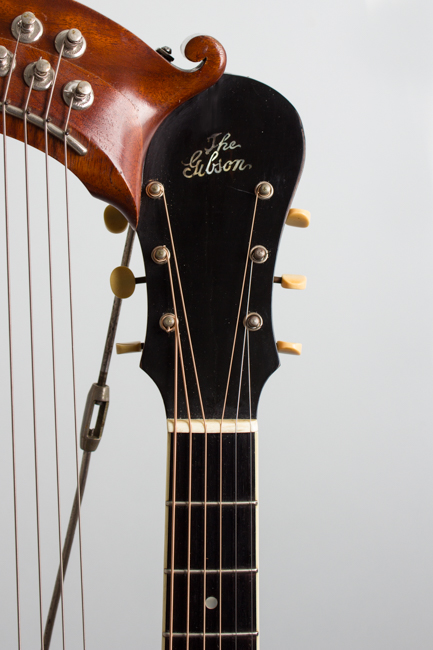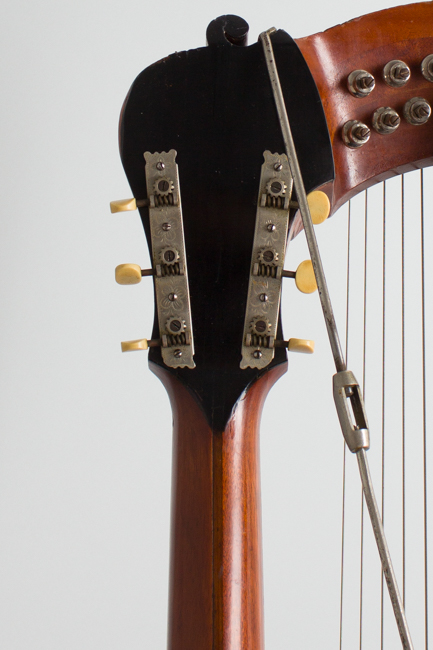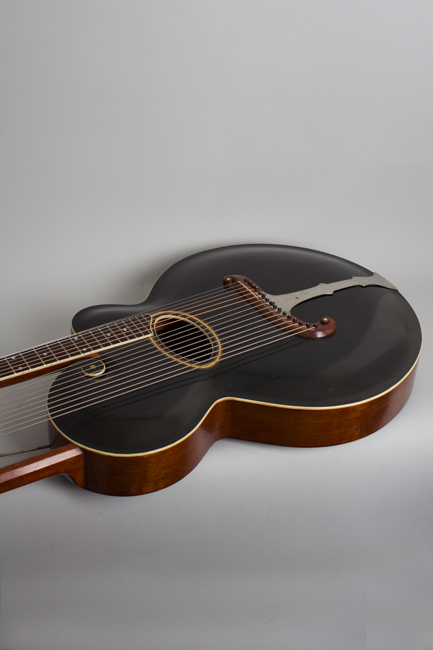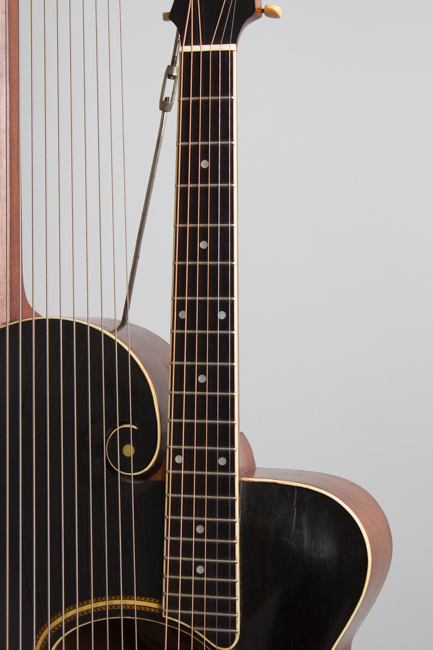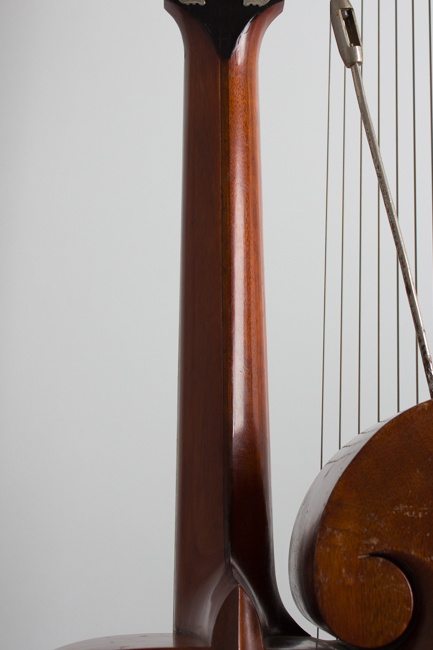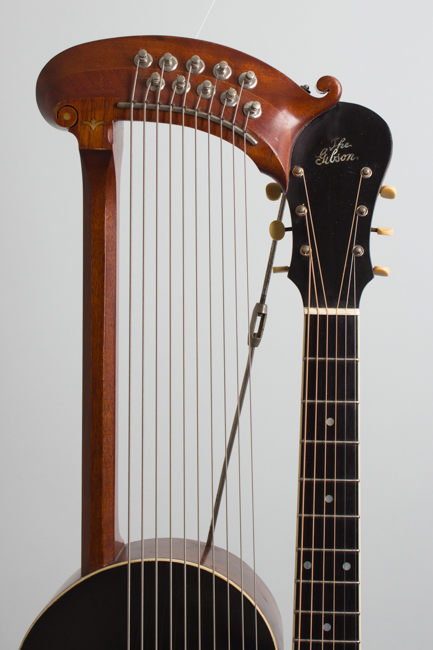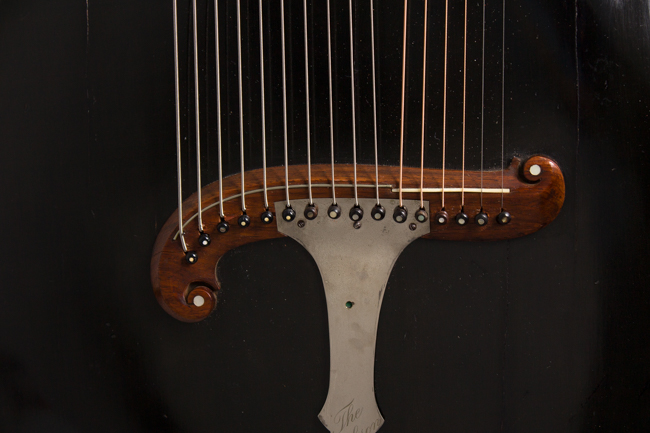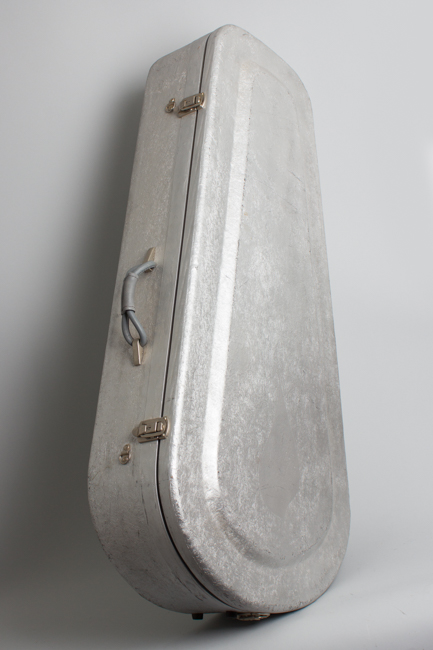Gibson Style U Harp Guitar (1908)
Gibson Style U Model Harp Guitar (1908), made in Kalamazoo, Michigan, serial # 7554, black top, natural back and sides finish, birch back, mahogany sides, spruce top; magogany neck with ebony fingerbord, Mark Leaf molded fiberglass hard shell case.
Of all the glories of Gibson over the last 100+ years, the Style U harp guitar is one of the most impressive -- visually, at least! This is an extremely rare and early example dating to the second half of 1908, still featuring Orville's ghostly face peering from the label inside. It would be one of the last of the original pattern pin-bridge, 21" wide models. The Style U was scaled down a bit and re-styled soon after to an "only" 18 1/2" wide behemoth with the new floating trapeze tailpiece. Having played this one we think that revision was a mistake, because the huge sound of this Style U is vastly superior to any later example we have heard!
While in 1908 guitars were still less important sales-wise to the company than mandolins, Gibson made considerable advertising capital out of the harp guitar. In the 1900s "aught years" the Gibson company was full of ideas, the most radical instrument innovator of the time. They offered several styles of harp-guitar from their beginnings in 1903, but by this point had settled on just one model, the Style U. For many years this multi-string behemoth topped the company's line, mostly intended to provide sonic underpinning for the mandolin orchestras that were the main outlet for Gibson products.
This early Style U is built on a massive 21" wide body, with an elaborate upper scroll. The ebony-finished hand-carved spruce top and sports a wide oval soundhole trimmed with half-herringbone and ivoroid. Internally the body has two massive longitudinal braces running from front to rear edge not touching the top or back. A long octagonal solid arm extension emerges from the scroll above the neck supporting the tuners for the 10 sub-bass strings. These sub-bass array are tuned with a zither-style wrench, the tuners mounted in echelon on a swooping carved wooden block with daintily scrolled ends. These strings were intended to be tuned chromatically down from D#, slightly different from Gibson's later system. There is a turn-buckle adjustor running to the join of the headstock pieces, presumably intended to offset the extreme tension involved.
The long carved 16-string pin bridge with scrolled ends has a bone saddle for the play strings, with a wire saddle for the sub-basses. It is supplemented by a very elaborate metal "Gibson bridge stay" spanning the lower top screwed both to the bridge and the endblock. The neck is huge and chunky with a heavy "V" profile and a bound, dot inlaid ebony fingerboard. The headstock is rounded on the top, solidly attached to the harp-string pin block on its upper edge. It has a pearl "the Gibson" logo and the familiar engraved-plate strip tuners used on most period guitars from Kalamazoo.
While the Gibson harp-guitars are not generally considered the sonic equals of the Larson-built Dyers that were their primary competitors, this early Style U is quite a bit more powerful and sweeter sounding than the more familiar later examples. The pin bridge construction seems to be a major sonic advantage here, and the larger body gives better life to sub-bass strings. It is also one of the most visually impressive and imposing fretted instruments ever made This one is set up to be playable (although you'll have to figure out how to use the harp strings yourself!) and even with some old repair and cosmetic wear is the coolest and absolutely the best sounding example of this glorious beast we have ever handled.
Overall length is 47 1/2 in. (120.6 cm.), 21 in. (53.3 cm.) wide at lower bout, and 3 1/2 in. (8.9 cm.) in depth, measured at side of rim. Scale length is 25 3/4 in. (654 mm.). Width of nut is 1 3/4 in. (44 mm.).
This early Style U is a fantastic Art Nouveau survivor and would be the absolute centerpiece for any fretted collection! Well past its 115th birthday, this Style U shows some fairly minor wear and repair but considering its age and size is relatively well-preserved overall. There are several long grain splits to the spruce top and one on the back, all solidly but visibly repaired with some light touch up. The ebony varnish top finish appears to have been polished out when this work was done but not overfinished. Apart from this the finish remains original and mostly fairly clean, showing some wear and scratches on the upper back and especially on the upper rim, where it looks like some sort of case rubbing resulted in heavier scratching at the apex of each bout. There is a small repair at the join of the headstocks solidly but visibly done.
All hardware is original and complete; this early model never had a pickguard. There is a small screw hole in the center of the metal bridge stay; we are not sure why. The ebony fingerboard was neatly refretted and rebound, the wire is somewhat larger then the period pattern but definitely more comfortable to play.
Everything on the instrument works as intended and the harp section is strung and tuned as per Gibson's 1910's pattern, in a chromatic array from the D# below the low E string down. The bone saddle has been subtly re-contoured to make the action a bit more friendly to a modern player, and this is a playable guitar if you have the reach to hold it! It resides in an absolutely enormous Mark Leaf Fiberglass HSC that is larger than some refrigerators, so shipping on this piece will be unusually costly. Overall Excellent - Condition.
Of all the glories of Gibson over the last 100+ years, the Style U harp guitar is one of the most impressive -- visually, at least! This is an extremely rare and early example dating to the second half of 1908, still featuring Orville's ghostly face peering from the label inside. It would be one of the last of the original pattern pin-bridge, 21" wide models. The Style U was scaled down a bit and re-styled soon after to an "only" 18 1/2" wide behemoth with the new floating trapeze tailpiece. Having played this one we think that revision was a mistake, because the huge sound of this Style U is vastly superior to any later example we have heard!
While in 1908 guitars were still less important sales-wise to the company than mandolins, Gibson made considerable advertising capital out of the harp guitar. In the 1900s "aught years" the Gibson company was full of ideas, the most radical instrument innovator of the time. They offered several styles of harp-guitar from their beginnings in 1903, but by this point had settled on just one model, the Style U. For many years this multi-string behemoth topped the company's line, mostly intended to provide sonic underpinning for the mandolin orchestras that were the main outlet for Gibson products.
This early Style U is built on a massive 21" wide body, with an elaborate upper scroll. The ebony-finished hand-carved spruce top and sports a wide oval soundhole trimmed with half-herringbone and ivoroid. Internally the body has two massive longitudinal braces running from front to rear edge not touching the top or back. A long octagonal solid arm extension emerges from the scroll above the neck supporting the tuners for the 10 sub-bass strings. These sub-bass array are tuned with a zither-style wrench, the tuners mounted in echelon on a swooping carved wooden block with daintily scrolled ends. These strings were intended to be tuned chromatically down from D#, slightly different from Gibson's later system. There is a turn-buckle adjustor running to the join of the headstock pieces, presumably intended to offset the extreme tension involved.
The long carved 16-string pin bridge with scrolled ends has a bone saddle for the play strings, with a wire saddle for the sub-basses. It is supplemented by a very elaborate metal "Gibson bridge stay" spanning the lower top screwed both to the bridge and the endblock. The neck is huge and chunky with a heavy "V" profile and a bound, dot inlaid ebony fingerboard. The headstock is rounded on the top, solidly attached to the harp-string pin block on its upper edge. It has a pearl "the Gibson" logo and the familiar engraved-plate strip tuners used on most period guitars from Kalamazoo.
While the Gibson harp-guitars are not generally considered the sonic equals of the Larson-built Dyers that were their primary competitors, this early Style U is quite a bit more powerful and sweeter sounding than the more familiar later examples. The pin bridge construction seems to be a major sonic advantage here, and the larger body gives better life to sub-bass strings. It is also one of the most visually impressive and imposing fretted instruments ever made This one is set up to be playable (although you'll have to figure out how to use the harp strings yourself!) and even with some old repair and cosmetic wear is the coolest and absolutely the best sounding example of this glorious beast we have ever handled.
Overall length is 47 1/2 in. (120.6 cm.), 21 in. (53.3 cm.) wide at lower bout, and 3 1/2 in. (8.9 cm.) in depth, measured at side of rim. Scale length is 25 3/4 in. (654 mm.). Width of nut is 1 3/4 in. (44 mm.).
This early Style U is a fantastic Art Nouveau survivor and would be the absolute centerpiece for any fretted collection! Well past its 115th birthday, this Style U shows some fairly minor wear and repair but considering its age and size is relatively well-preserved overall. There are several long grain splits to the spruce top and one on the back, all solidly but visibly repaired with some light touch up. The ebony varnish top finish appears to have been polished out when this work was done but not overfinished. Apart from this the finish remains original and mostly fairly clean, showing some wear and scratches on the upper back and especially on the upper rim, where it looks like some sort of case rubbing resulted in heavier scratching at the apex of each bout. There is a small repair at the join of the headstocks solidly but visibly done.
All hardware is original and complete; this early model never had a pickguard. There is a small screw hole in the center of the metal bridge stay; we are not sure why. The ebony fingerboard was neatly refretted and rebound, the wire is somewhat larger then the period pattern but definitely more comfortable to play.
Everything on the instrument works as intended and the harp section is strung and tuned as per Gibson's 1910's pattern, in a chromatic array from the D# below the low E string down. The bone saddle has been subtly re-contoured to make the action a bit more friendly to a modern player, and this is a playable guitar if you have the reach to hold it! It resides in an absolutely enormous Mark Leaf Fiberglass HSC that is larger than some refrigerators, so shipping on this piece will be unusually costly. Overall Excellent - Condition.
